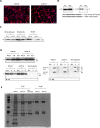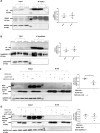Differential mitochondrial protein interaction profile between human translocator protein and its A147T polymorphism variant
- PMID: 35522669
- PMCID: PMC9075623
- DOI: 10.1371/journal.pone.0254296
Differential mitochondrial protein interaction profile between human translocator protein and its A147T polymorphism variant
Abstract
The translocator protein (TSPO) has been implicated in mitochondrial transmembrane cholesterol transport, brain inflammation, and other mitochondrial functions. It is upregulated in glial cells during neuroinflammation in Alzheimer's disease. High affinity TSPO imaging radioligands are utilized to visualize neuroinflammation. However, this is hampered by the common A147T polymorphism which compromises ligand binding. Furthermore, this polymorphism has been linked to increased risk of neuropsychiatric disorders, and possibly reduces TSPO protein stability. Here, we used immunoprecipitation coupled to mass-spectrometry (IP-MS) to establish a mitochondrial protein binding profile of wild-type (WT) TSPO and the A147T polymorphism variant. Using mitochondria from human glial cells expressing either WT or A147T TSPO, we identified 30 WT TSPO binding partners, yet only 23 for A147T TSPO. Confirming that A147T polymorphism of the TSPO might confer loss of function, we found that one of the identified interactors of WT TSPO, 14-3-3 theta (YWHAQ), a protein involved in regulating mitochondrial membrane proteins, interacts much less with A147T TSPO. Our data presents a network of mitochondrial interactions of TSPO and its A147T polymorphism variant in human glial cells and indicate functional relevance of A147T in mitochondrial protein networks.
Conflict of interest statement
The authors have declared that no competing interests exist.
Figures



Similar articles
-
Effects of genetic variants in the TSPO gene on protein structure and stability.PLoS One. 2018 Apr 11;13(4):e0195627. doi: 10.1371/journal.pone.0195627. eCollection 2018. PLoS One. 2018. PMID: 29641545 Free PMC article.
-
Reversing binding sensitivity to A147T translocator protein.RSC Med Chem. 2020 Mar 12;11(4):511-517. doi: 10.1039/c9md00580c. eCollection 2020 Apr 1. RSC Med Chem. 2020. PMID: 33479652 Free PMC article.
-
Tricyclic heterocycles display diverse sensitivity to the A147T TSPO polymorphism.Eur J Med Chem. 2020 Dec 1;207:112725. doi: 10.1016/j.ejmech.2020.112725. Epub 2020 Aug 15. Eur J Med Chem. 2020. PMID: 32920427
-
Recent Developments in TSPO PET Imaging as A Biomarker of Neuroinflammation in Neurodegenerative Disorders.Int J Mol Sci. 2019 Jun 28;20(13):3161. doi: 10.3390/ijms20133161. Int J Mol Sci. 2019. PMID: 31261683 Free PMC article. Review.
-
The translocator protein (18kDa) and its role in neuropsychiatric disorders.Neurosci Biobehav Rev. 2017 Dec;83:183-199. doi: 10.1016/j.neubiorev.2017.10.010. Epub 2017 Oct 18. Neurosci Biobehav Rev. 2017. PMID: 29054730 Review.
Cited by
-
New TSPO Crystal Structures of Mutant and Heme-Bound Forms with Altered Flexibility, Ligand Binding, and Porphyrin Degradation Activity.Biochemistry. 2023 Apr 4;62(7):1262-1273. doi: 10.1021/acs.biochem.2c00612. Epub 2023 Mar 22. Biochemistry. 2023. PMID: 36947867 Free PMC article.
References
-
- Papadopoulos V, Baraldi M, Guilarte TR, Knudsen TB, Lacapere JJ, Lindemann P, et al.. Translocator protein (18kDa): new nomenclature for the peripheral-type benzodiazepine receptor based on its structure and molecular function. Trends Pharmacol Sci. 2006;27(8):402–9. doi: 10.1016/j.tips.2006.06.005 - DOI - PubMed
-
- Li H, Yao Z, Degenhardt B, Teper G, Papadopoulos V. Cholesterol binding at the cholesterol recognition/ interaction amino acid consensus (CRAC) of the peripheral-type benzodiazepine receptor and inhibition of steroidogenesis by an HIV TAT-CRAC peptide. Proc Natl Acad Sci U S A. 2001;98(3):1267–72. doi: 10.1073/pnas.98.3.1267 - DOI - PMC - PubMed
MeSH terms
Substances
LinkOut - more resources
Full Text Sources
Miscellaneous

